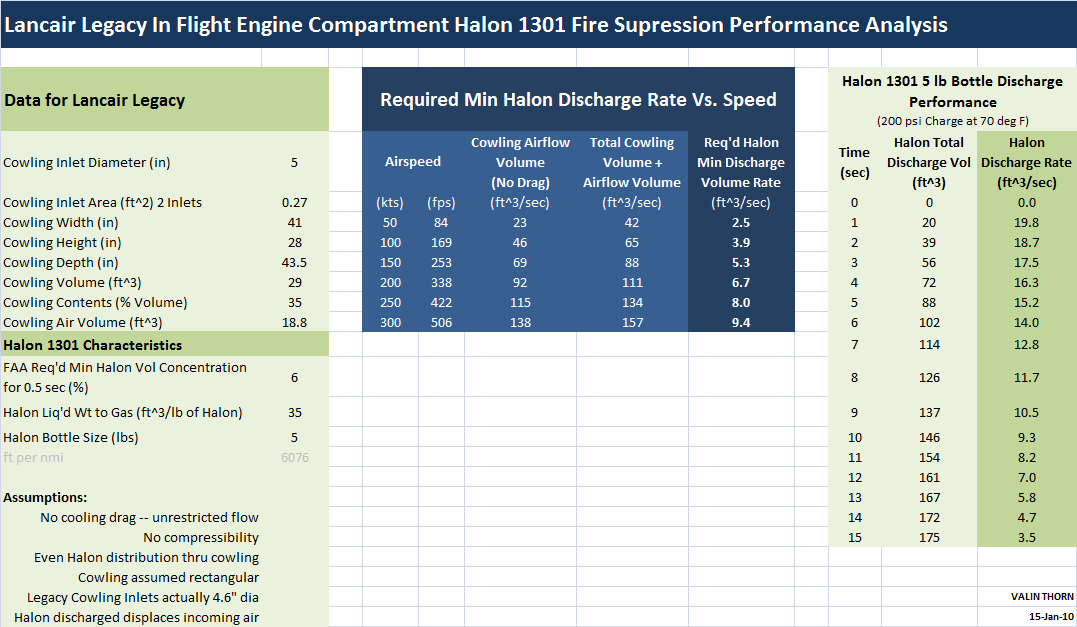Hey LML
gang,
A big thanks
to everyone that responded to my request for comments and advice regarding in
flight engine fire suppression. There were three main questions
raised:
1.
Is Halon 1301
the best agent for an engine fire?
2.
How effective
would a fire suppressant be in flight with the high air flow through the
cowling?
3.
Even if
extinguished, a fire may be likely to re-ignite after the suppressant is flushed
away by the air flow.
Here’s what
I’ve learned in research related to these questions…
Is Halon 1301
the best agent for an engine fire?
Yes.
Everything I’ve found in research indicates that for this application it is the
best. It requires a very low concentration for a very short period of time
to extinguish a fire. The FAA certification minimum is 6% concentration by
volume for at least 0.5 seconds. It actually works in milliseconds,
though. It has a high vapor pressure, about 200 psi, and disperses
throughout the atmosphere very rapidly into nooks and crannies. It is also
non-corrosive and leaves no residue – so no cleaning is required if
discharged. There is also no acute toxicity for humans below 10%
concentrations.
How effective
would a fire suppressant be in flight with the high air flow through the
cowling?
This was also
one of my biggest questions and I couldn’t find any analysis on the internet to
answer this. So, I worked up a simplified but conservative analysis.
Below is a screen shot of part of my spreadsheet. I talked with
Safecraft’s Don Warren and he provided three key pieces of data on Halon
1301. He said one pound of Halon 1301 as a gas will occupy 35 cubic feet
at sea level pressure. He provided two points of data on the Halon
discharge rate from their 5 lb bottle at 200 psi. In 5 seconds 2.5 lbs of
Halon will be discharged and all 5 lbs will be discharged in 15 seconds.
So with those two points I created the table on the right of the Halon 1301 5 lb
Bottle Discharge Performance.
My basic
analytical approach was to look at the total volume of air each second that
Halon would need to be dispersed in, to see what the minimum 6% concentration
volume would be vs. airspeed. The volume required is the total airflow
volume through the inlets, for the time period being examined, plus the cowling
volume. I made conservative assumptions – for example, no cooling drag or
slowing down of the air through the cowling, I assumed larger than actual
cowling inlets, and larger than actual cowling (simplified as cube at max
dimensions).

I was happy
to see, that even with these conservative assumptions, with discharge of a 5 lb
bottle of Halon 1301 at 300 kts there would be 10 seconds with more than a 6%
concentration of Halon to knock down a fire (only a half second required for
spec). You see this by comparing the Halon Discharge Rate to the Required
Minimum Discharge Rate vs. Airspeed.
After doing
this analysis, I found a reference in a magazine article that pointed out that a
6 lb bottle of Halon 1301 is all that’s required on a 747’s engine to knock out
an engine fire… So with this analysis and the 747 benchmark, I’m convinced
a 5 lb bottle of Halon 1301, with proper positioning of discharge outlets in the
cowling, can knock down an in flight engine fire on a Lancair
Legacy.
Even if
extinguished, a fire may be likely to re-ignite after the suppressant is flushed
away by the air flow.
Yes.
And of course LML’ers have pointed out that the proper procedure is to shut down
the engine, cut off the fuel flow, cut off electrical power, and then discharge
the Halon. So you don’t want to do it too fast – before cutting off
potential fuel and ignition sources. One interesting thing I found in
research was reference to an Air Force study that found you also don’t want to
wait too long to put out the fire because it will eventually heat things up so
much that the hot parts may serve as re-ignition sources. They said the
suppressant should be discharged within 14 seconds after the start of the fire
for the cases they were studying. So there’s too fast and waiting too
long… One advantage of going with a 5 lb bottle, which is much more than
required to knock down a fire in a Legacy, is that it will ensure additional
time to allow the airflow to cool things off to help reduce the risk of fire hot
parts re-igniting the fire.
As a passing
note, Halon 1301 systems are only certified up to 130 deg F operating
environments so the tank should not be installed under the cowling – somewhere
in the cabin is best. If you only have room to put a Halon system under
the cowling you should use Halon 1211 which is certified for up to 200 deg
F. The downside of 1211 is that is has a much lower vapor pressure and
will require more attention to the discharge nozzles for good dispersion in the
space. BTW, 1211 is the recommended Halon for cabin extinguishers because
it discharges in a stream before vaporizing so you can aim it accurately at the
fire.
Anyway, I
wanted to share this with the community for those considering fire suppression
systems and hope this is helpful. Thanks again for everyone’s
advice. Let me know if you have any comments, questions or find errors in
my analysis I need to correct.
Fire
detection is a critical part of a fire suppression system and I’m still studying
options there…
Thanks,
Valin
Thorn
Legacy under
construction, still
Houston,
Texas